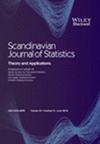分歧与决策P值:一个值得在理论和实践中做出的区分;或者,分歧P值如何衡量证据,即使决策P值没有
IF 1
4区 数学
Q3 STATISTICS & PROBABILITY
引用次数: 6
摘要
“P值”有两种不同的定义,用于评估生成观测数据集的过程中提出的假设或模型。最初的定义从数据集偏离模型预期的程度开始,比如平方和或偏差统计量。然后,P值是根据模型和数据计算的参考分布中度量的顺序位置,并被视为数据和模型之间的单位比例兼容性指数。在另一种定义中,P值是单位区间上的随机变量,其实现可以与截断α相比较,以生成在模型和特定替代方案下具有已知错误率的决策规则。通常假设这种决策P值的实现总是对应于发散P值。但事实并非如此:决策P值可能违反直观的单样本相干性准则,而散度P值则不会。因此,在教学中应该仔细区分发散P值和决策P值,当分析目标是总结证据而不是执行决策规则时,发散P值是相关的选择。本文章由计算机程序翻译,如有差异,请以英文原文为准。
Divergence versus decision P‐values: A distinction worth making in theory and keeping in practice: Or, how divergence P‐values measure evidence even when decision P‐values do not
There are two distinct definitions of “P‐value” for evaluating a proposed hypothesis or model for the process generating an observed dataset. The original definition starts with a measure of the divergence of the dataset from what was expected under the model, such as a sum of squares or a deviance statistic. A P‐value is then the ordinal location of the measure in a reference distribution computed from the model and the data, and is treated as a unit‐scaled index of compatibility between the data and the model. In the other definition, a P‐value is a random variable on the unit interval whose realizations can be compared to a cutoff α to generate a decision rule with known error rates under the model and specific alternatives. It is commonly assumed that realizations of such decision P‐values always correspond to divergence P‐values. But this need not be so: Decision P‐values can violate intuitive single‐sample coherence criteria where divergence P‐values do not. It is thus argued that divergence and decision P‐values should be carefully distinguished in teaching, and that divergence P‐values are the relevant choice when the analysis goal is to summarize evidence rather than implement a decision rule.
求助全文
通过发布文献求助,成功后即可免费获取论文全文。
去求助
来源期刊

Scandinavian Journal of Statistics
数学-统计学与概率论
CiteScore
1.80
自引率
0.00%
发文量
61
审稿时长
6-12 weeks
期刊介绍:
The Scandinavian Journal of Statistics is internationally recognised as one of the leading statistical journals in the world. It was founded in 1974 by four Scandinavian statistical societies. Today more than eighty per cent of the manuscripts are submitted from outside Scandinavia.
It is an international journal devoted to reporting significant and innovative original contributions to statistical methodology, both theory and applications.
The journal specializes in statistical modelling showing particular appreciation of the underlying substantive research problems.
The emergence of specialized methods for analysing longitudinal and spatial data is just one example of an area of important methodological development in which the Scandinavian Journal of Statistics has a particular niche.
 求助内容:
求助内容: 应助结果提醒方式:
应助结果提醒方式:


